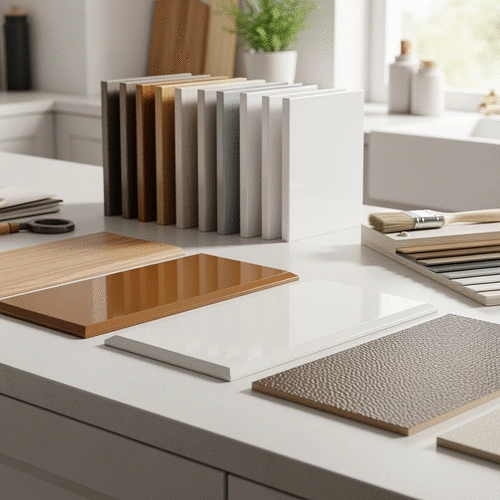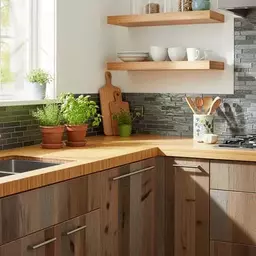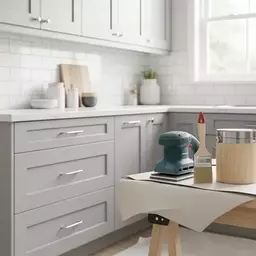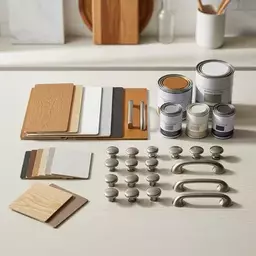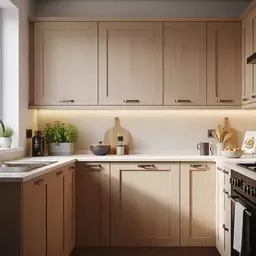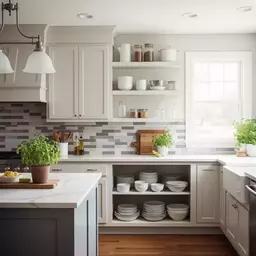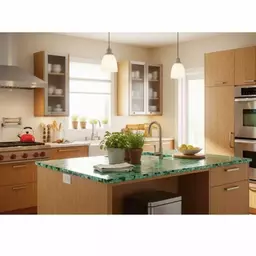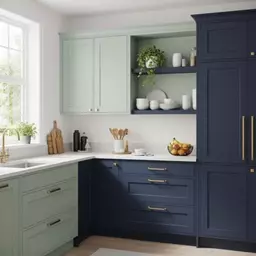Considering a kitchen refresh? Resurfacing your cabinets can provide a stunning transformation without the hassle of a full renovation. But before you dive in, it’s crucial to understand the impact of material selection and maintenance on your investment.
What You Will Learn
- Choosing quality materials for cabinet resurfacing enhances both durability and aesthetic appeal.
- Different materials, like laminate and solid wood, have unique advantages and budget implications.
- Proper maintenance techniques are essential for preserving the beauty and longevity of your cabinets.
- Regular inspections can help identify signs of wear and prompt timely repairs or refinishing.
- Investing in eco-friendly materials can lead to long-term savings, even with higher initial costs.
Material Selection Impact on Kitchen Cabinet Resurfacing
This section highlights the effects of various materials on durability, aesthetics, and budget for kitchen cabinet resurfacing.
Durability
Solid wood offers unmatched durability, while laminate is budget-friendly but may not last long.
Aesthetics
The finish and color of materials can significantly change the kitchen's appearance, with acrylic providing a sleek look.
Impact on Budget
Choose laminate for lower upfront costs, but consider solid wood for longevity and value over time.
Maintenance Considerations
Durable materials may require less maintenance, making them a good investment for long-term use.
Understanding Kitchen Cabinet Resurfacing in Australia
When it comes to breathing new life into your kitchen, cabinet resurfacing is one of the most effective strategies. It not only saves you money compared to a complete renovation but also allows you to personalize your space without the added stress and mess. Have you ever looked at your kitchen and thought, “I wish I could change this?” Well, with the right approach to resurfacing, you can!
In Australia, choosing the right materials for your cabinet resurfacing project is crucial. Different materials offer varying advantages, whether you're looking for durability, aesthetics, or budget-friendliness. Let’s explore why material selection is so essential for a successful kitchen transformation! For a comprehensive guide on the benefits of kitchen resurfacing, you can refer to this guide to kitchen resurfacing.
Importance of Choosing the Right Materials
Choosing the right materials for your kitchen cabinet resurfacing can significantly impact both the durability and the overall aesthetic appeal of your space. Think about it: have you ever seen beautifully resurfaced cabinets that looked brand new? That’s the power of selecting quality materials! Using durable materials can withstand the test of time, especially in busy kitchens where wear and tear can happen.
Here are a few factors to consider when choosing your materials:
- Durability: Some materials hold up better against humidity and heat.
- Aesthetics: The finish and color can dramatically change the look of your kitchen.
- Maintenance: Consider how easy it will be to keep the cabinets looking fresh over time.
How Material Selection Affects Durability and Aesthetics
The materials you choose can shape the longevity of your kitchen cabinets. For instance, solid wood offers unmatched durability and a classic look but often comes at a higher price. On the other hand, modern materials like acrylic or laminate can provide a sleek appearance and are easier to maintain. It’s all about finding that balance between style and functionality.
Imagine walking into your kitchen, feeling the warmth of natural wood or the sleekness of a glossy acrylic finish. Which vibe resonates with you? This is where personal taste plays a crucial role in your decision-making process. For more insights on different finishing materials and their applications, consider exploring resources like the NMTAFE Furniture Finishing guide.
Impact on Kitchen Renovation Budget
Your choice of material will also have a direct impact on your kitchen renovation budget. Some materials may seem affordable upfront but require more maintenance or replacements down the line. This is a crucial consideration for homeowners looking for sustainable options. At Kitchen Refacing Guide, we encourage you to think long-term when making your selections!
Here’s how different materials can affect your overall budget:
- Laminate: Generally more budget-friendly, but may not last as long.
- Solid Wood: Higher initial cost, but great longevity and value.
- Eco-Friendly Options: May have higher upfront costs but save money in the long run through durability and lower maintenance.
Diverse Range of Materials for Cabinet Resurfacing
With so many material options available, it’s essential to dive deeper into what's out there. From laminate to solid wood, each option brings its own unique pros and cons to the table. Let's explore these materials in detail to help you make the right choice for your kitchen renovation!
Interactive Poll: Your Cabinet Style
As you consider your kitchen cabinet resurfacing project, we’d love to hear from you! Which material do you find most appealing for your kitchen cabinets? Choose one of the options below:
Frequently Asked Questions about Kitchen Cabinet Resurfacing
Here are some common questions about kitchen cabinet resurfacing, material selection, and maintenance.
Q: What is kitchen cabinet resurfacing?
A: Kitchen cabinet resurfacing, also known as refacing, is the process of updating the exterior of your existing cabinets. This typically involves replacing cabinet doors and drawer fronts and applying a new veneer to the cabinet boxes, giving your kitchen a fresh new look without a full renovation.
Q: How does material selection impact the cost of cabinet resurfacing?
A: The material you choose significantly impacts the overall cost. Laminate is generally more budget-friendly upfront, while solid wood has a higher initial cost but offers greater longevity and value. Eco-friendly options might also have higher initial costs but can save money long-term due to durability and reduced maintenance needs.
Q: What are the best materials for durability in kitchen cabinets?
A: Solid wood is renowned for its unmatched durability. However, modern materials like acrylic can also offer good durability along with a sleek aesthetic. Laminate is a more budget-friendly option but may not last as long as solid wood or high-quality acrylic.
Q: How often should I perform maintenance on my resurfaced cabinets?
A: Regular cleaning with appropriate products for your cabinet material is recommended. Beyond daily cleaning, conducting periodic inspections for scratches, dents, peeling, or fading colors will help you identify issues early and address them promptly, potentially saving on larger repairs.
Q: Can resurfacing improve the value of my home?
A: Yes, a well-executed cabinet resurfacing project can significantly enhance the aesthetic appeal and functionality of your kitchen, which in turn can increase your home's market value. It's a cost-effective way to modernize your kitchen compared to a full renovation, offering a good return on investment. For more information on kitchen renovations and their impact, you can visit Local Search's guide on kitchen renovations.
Long-Term Maintenance for Resurfaced Kitchen Cabinets
Once you've completed your kitchen cabinet resurfacing project, the journey doesn’t end there! Proper maintenance is crucial to ensure that your cabinets continue to look stunning and serve you well for years to come. In this section, I’ll share some essential care tips that will help you preserve your newly resurfaced kitchen cabinets, making them a lasting investment in your home.
Remember, maintaining your cabinets isn’t just about cleaning; it’s about understanding the materials you’ve chosen and how to best care for them. In my experience with various kitchen renovations, attention to detail in maintenance has always paid off in the long run!
Essential Care Tips to Preserve Your Cabinets
To keep your cabinets looking fresh and new, you’ll want to follow some straightforward cleaning and upkeep guidelines tailored to the materials used in your resurfacing project. Here are some key tips:
- For Laminate Cabinets: Use a soft cloth and mild detergent. Avoid abrasive cleaners that can scratch the surface.
- For Melamine: Wipe with a damp cloth and a gentle cleaner to prevent damage to the glossy finish.
- For Solid Wood: Dust regularly and apply a suitable wood conditioner to maintain its luster.
- For Thermofoil: Clean with warm soapy water and avoid heat exposure to prevent peeling.
Additionally, be on the lookout for signs that indicate your cabinets might need repair or refinishing. Some common indicators include:
- Visible scratches and dents.
- Peeling or bubbling surfaces.
- Fading colors, especially in direct sunlight.
Recommended Tools and Products for Cabinet Maintenance
Having the right tools and products on hand can make a big difference in maintaining your cabinets. Here are some essentials that you should consider for your cabinet care toolkit:
- Cleaning Tools: Soft microfiber cloths, sponge scrubbers, and non-abrasive pads.
- Painting Tools: Spray guns, rollers, and brushes for touch-ups.
- Maintenance Products: Gentle wood cleaner, laminate-safe polish, and adhesive sealants for repairs.
When selecting adhesives, sealants, and finishing products, always ensure they are compatible with your specific cabinet material. For example, a high-quality wood glue will work wonders for solid wood repairs, while specialized laminate adhesives provide a strong bond for resurfacing projects.
Summary of Key Insights on Kitchen Cabinet Resurfacing
As we wrap up this discussion on long-term maintenance for resurfaced kitchen cabinets, it's essential to remember that regular care can significantly extend their lifespan and beauty. With the right knowledge and tools, your cabinets will not only enhance the functionality of your kitchen but also keep it looking stylish for many years.
So, are you ready to take the next steps in your kitchen resurfacing journey? Investing in quality materials and maintenance practices will pay off in the end, transforming your kitchen into a welcoming space that reflects your personal style!
Recap of Key Points
Here is a quick recap of the important points discussed in the article:
- Cabinet Resurfacing Benefits: A cost-effective way to revitalize your kitchen without a full renovation.
- Material Selection: Choosing durable, aesthetically pleasing materials is crucial for long-term satisfaction.
- Impact on Budget: Understanding the long-term costs of materials can help you make sustainable choices.
- Maintenance Tips: Regular cleaning and care tailored to specific materials will extend the lifespan of your cabinets.
- Essential Tools: Equip yourself with the right cleaning and maintenance tools to keep your cabinets looking fresh.

